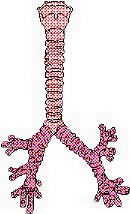 Guidelines for the
Diagnosis and Management of Asthma
Guidelines for the
Diagnosis and Management of Asthma
 Guidelines for the
Diagnosis and Management of Asthma
Guidelines for the
Diagnosis and Management of Asthma
The National Asthma Education and Prevention Program released the Report of the Second Expert Panel on the Guidelines for the Diagnosis and Management of Asthma. The report, based on a comprehensive review of the scientific evidence accumulated during the past 6 years, updates the first asthma clinical practice guidelines released in 1991.
The new report continues to advocate a step-wise approach to pharmacological therapy. But based on the enhanced understanding of inflammation and its contribution to abnormalities in lung function, it is emphatic that persistent asthma should be controlled with daily anti-inflammatory medications. Medications are now categorized into two general classes: long-term control medications, used to achieve and maintain control of persistent asthma, and quick-relief medications, used to treat acute symptoms and attacks.
The report also establishes more relevant classifications for asthma severity and links its recommendations for the amount and frequency of medication to the severity of each patient's asthma. The new classifications are mild intermittent, mild persistent, moderate persistent, and severe persistent.
The new report confirms the close relationship between allergy and asthma in most asthma patients and the importance of reducing exposures to indoor and outdoor allergens. But it expands on this by establishing that allergy testing should be used to identify perennial indoor allergens for certain asthma patients and by including recommendations for controlling other factors that can increase asthma symptoms, such as aspirin/NSAIDS and respiratory infections.
The report also makes the point that asthma onset may possibly be prevented by reducing exposures to allergens and tobacco smoke. Stating that undertreatment of asthma in young children is a problem, it also includes a new section on asthma in infants and young children.
The new report establishes clear criteria and mechanisms for an asthma diagnosis and strongly recommends that spirometry be used in an initial diagnostic work-up. It also includes new recommendations for use of spirometry and peak flow monitoring in diagnosing and monitoring asthma.
As in the 1991 Expert Panel Report, education for an active partnership with patients is advocated as the cornerstone of asthma management. The new report calls for starting education at the time of asthma diagnosis, integrating it into every step of clinical asthma care, and tailoring it specifically to the needs of each patient, with sensitivity to cultural beliefs and practices. Patient outcomes should be measured in terms of the patients' perceptions of improvement, especially quality of life and the ability to live a normal, active life.
The report will be converted into a concise practical guide for physicians and widely distributed. The full Expert Panel Report is available online at http://www.nhlbi.nih.gov/nhlbi/lung/asthma/prof/asthgdln.htm
Xerox copies can be obtained by sending a check for $20 to the:
NHLBI Information Center
PO Box 10305
Bethesda, MD 20824-0105.
Return to Top Return to Pulmonary Paper